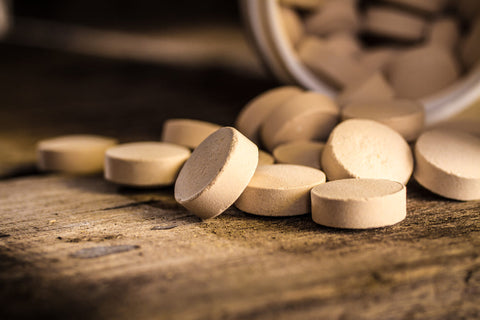Both Brewer’s Yeast & Nutritional Yeast Are Excellent Superfoods.
Just two tablespoons of any of them will meet our nutritional needs for B Vitamins that boost our energy, mood, brain function, and cell metabolism.
Nutritional Yeast is higher in B Vitamins while Brewer's Yeast is very rich in some Minerals such as Chromium, Potassium and Selenium that are not found in Nutritional Yeast. Therefore, Brewer's Yeast is definitely the better overall source of nutrients, unless you need especially B Vitamins. In this case, taking both of them seems to be an ideal solution.
The table below shows approximate nutritional content per 2 heaped tablespoons (about 15 gr) in both types of yeast:

As far as Chromium content in Brewer's Yeast is concerned, according to some sources Brewer's Yeast may contain 17 mcg of Chromium (with excellent bioavailability) per 2 tablespoons (15-16g) (40% RDA). However, the content of this mineral depends on its concentration in the medium (whole grains) the yeast feeds on and the quality of the soil the medium was grown in. Please notice, there is no Chromium, Potassium or Selenium in the Nutritional Yeast.
Brewer’s Yeast
Brewer’s Yeast (single cell fungus/yeast) is a by-product of beer making. The same yeast is used in bread making (yeast produces more carbon dioxide gas to make the bread rise). This yeast is a living organism that feeds on the sugars of the grains used to make beer or bread and ferments them into carbon dioxide and ethyl alcohol.
In bread making, the yeast remains in the bread but is deactivated by heat in the baking process.
In beer making, the yeast is removed and heated to deactivate it. It is then dried and made into a powder or flakes. It is this powdered or flaked yeast that is the Brewers Yeast supplement available at health food stores.
What makes this yeast very nutritious is that while it is in its living and active form, it takes up a number of proteins, minerals and vitamins from the grains and other ingredients used in beer making. These nutrients remain in the dried yeast and when this yeast is consumed as a food supplement, it provides the body with these nutrients.
Brewer’s Yeast is very high in the trace mineral Chromium which must be present in order for insulin to do its work of moving glucose from the blood into the cell (thus regulating blood sugar levels). The chromium found in Brewer’s Yeast is known as a Glucose Tolerance Factor (GTF). It is in this form that our body is able to use this mineral to help regulate insulin and thereby normalise blood sugar levels. Therefore, Brewer’s Yeast can be very helpful to those with increased blood glucose, diabetics, as well as people with hypoglycaemia (low blood sugar). Some studies indicate that the GTF Chromium, found in Brewer’s Yeast, is more effective than simply supplementing with an isolated chromium supplements.

In 1959 Dr. Merts and Dr. Schwarz observed that animals on a Chromium depleted diets quickly developed glucose intolerance, which precedes the development of type II diabetes. However, when they gave the same animals food with Brewer's Yeast - a natural source of Chromium - the glucose intolerance was gone and animals became healthy again.
In 2014 the European Food Safety Authority, EFSA examined the absorbability of various Chromium compounds and found out that the absorbability was very low, i.e. only between 0.1% to 2%. Even the absorption of Chromium from food was only 0.5% to 3%, which was marginally better than the absorption from inorganic supplements. However, they also discovered that Chromium in Chromium enriched Brewer's Yeast was absorbed up to 10 times better than inorganic chromium compounds like e.g. chromium chloride!
Brewer’s Yeast is a good source of the trace mineral Selenium. Selenium is required for normal thyroid and immune system function, and it is necessary to the body’s production of glutathione peroxidase, an antioxidant enzyme that is most important in controlling free radical damage to fatty tissues in the body.
Brewer’s Yeast is rich in many of the B-vitamins (although lower than Nutritional Yeast), but is lacking a bioavailable form of vitamin B-12, unless it is fortified with B12. Nutritional yeast has some B12 but it is not an active form (can’t be absorbed in the body).
Brewer’s Yeast has been found to be an excellent source of Protein (up to 50%). It has all the essential amino acids necessary for building proteins in the body.
Brewer’s Yeast is also an excellent source of Nucleic Acids.
Nutritional Yeast
Nutritional Yeast is made from the same type of yeast as used in the brewing industry. The difference is that Nutritional Yeast is grown on molasses instead of on grains. Nutritional Yeast is deactivated, dried and made into a powder or flakes.
Nutritional Yeast is high in B Vitamins (much higher than even Brewer’s Yeast). For example, the best and healthy natural source of Niacin (Vitamin B3) is Nutritional Yeast. It may contain 15-20mg of B3 per 1 tablespoon (7-8g) (100-160% RDA).
However, both types of yeast shouldn’t be regarded as sources of B12 unless they are fortified with this vitamin as B12 found in both yeasts is not a bioactive form.
Unlike Brewer’s Yeast, which is an excellent natural source of Chromium, Potassium, and Selenium, Nutritional Yeast does not contain them, unless it is fortified with these minerals.
Which Is Better Source Of Nutrients?
Both types of yeast are close relatives as they both are made from Saccharomyces cerevisiae species of yeast. However, they nutritional content is not the same because these yeasts are bred on different mediums (foods). Brewer's Yeast is grown on grains while Nutritional Yeast is grown on molasses.
If you need excellent quality Chromium to reduce sugar craving, regulate blood sugar and deal with diabetes, you need Brewer’s Yeast due to its high content of GTF Chromium, absorption of which is much better than that of other sources including food and supplements.
Brewer’s Yeast is also much better source of amino acids (protein) and minerals such as whopping 630 milligrams of Potassium and 63 micrograms of Selenium per 2 tablespoons, whereas nutritional yeast contains none (see table above)!
Both Brewer’s and Nutritional Yeast are a good source of Magnesium.
Torula Yeast
Torula yeast is made from the species Candida utilis and has become a common flavouring in foods like chips (crisps), biscuits and numerous processed foods.
It has a similar function to MSG – to add a salty, smoky flavour – and like MSG, can cause problems because of its high free glutamic acid content.
What About Candida Overgrowth?
Nutritional Yeast has been thought to cause candida overgrowth, but there doesn't seem to be a proof that it is possible. Candida thrives on sugars found in foods and not yeast, so an individual who takes nutritional yeast as a supplement should not contribute to Candida overgrowth. However, since some individuals still claim that it shouldn't be used by people who already suffer from Candidiasis, you need to make your own decision if it is something you are concern about.
Cautions
Inactive yeast contains free glutamic acid, which is believed to mimic the effects caused by MSG. Also yeast popular spreads, such as Marmite or Vegemite, are accused of having similar effect as MSG.
Even though nutritional yeasts aren’t alive, yet if you suffer from candidiasis or yeast infections, some suggest it is better to avoided them – especially torula yeast.
There is also some evidence of the presence of antibodies against brewer’s and nutritional yeast found in people with Crohn’s disease and ulcerative colitis – which means the body may sometimes treat these yeasts as foreign bodies and start immune reaction in individuals with oversensitive immune system. For this reason, it is probably better to avoid all types of yeasts if you suffer from any autoimmune conditions or allergies.
Interactions With Medication
Brewer’s Yeast contains tyramine which can negatively interact with antidepressant drug monoamine oxidase inhibitors (MAOI’s) and may increase blood pressure.
This same negative interaction can occur with users of Brewer’s Yeast and the pain relief drug Demerol.
Brewer’s Yeast can interact with type 1 diabetes medication.
Related Articles
- Health Benefits Of Chromium
- Kiss Your Sugar Cravings Goodbye
- Most Effective Ways to Suppress Appetite
- Obesity and Overweight
- Prevent Deficiencies With Multivitamins
Sources
Any information or product suggested on this website is not intended to diagnose, treat, cure or prevent any medical condition. Never disregard medical advice or delay in seeking it because of something you have read on this website. Consult your primary healthcare physician before using any supplements or making any changes to your regime.




